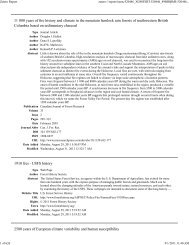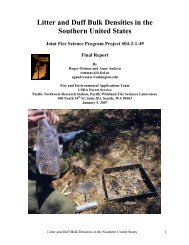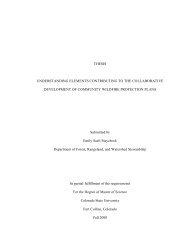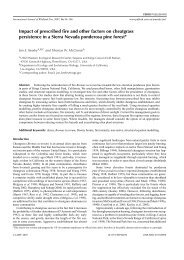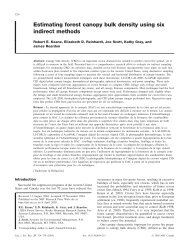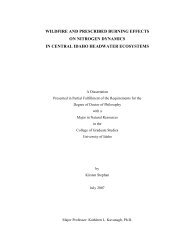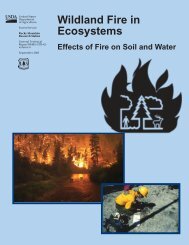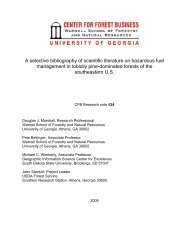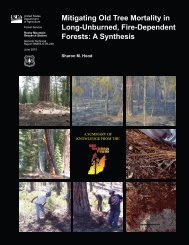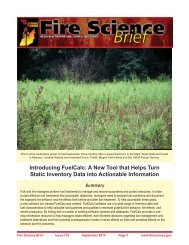Miscanthus sinensis - Joint Fire Science Program
Miscanthus sinensis - Joint Fire Science Program
Miscanthus sinensis - Joint Fire Science Program
You also want an ePaper? Increase the reach of your titles
YUMPU automatically turns print PDFs into web optimized ePapers that Google loves.
<strong>Miscanthus</strong> <strong>sinensis</strong><br />
September to October [33]. In Japan, Chinese silvergrass plants occurring at high latitudes or elevations may flower as<br />
much as 2 months earlier than those at lower latitudes and elevations (Adati 1958 cited in [96]). Chinese silvergrass<br />
undergoes end-of-season shoot senescence [57], and in some locations, culms become yellow and begin to wither in<br />
September [118]. Shoots developing late in the season may survive the winter [57].<br />
Chinese silvergrass may undergo seasonal changes in its rhizome carbohydrate reserves. In Japan, carbohydrate<br />
content in Chinese silvergrass rhizomes was depleted in June when new shoots were developing [46] but was restored<br />
in the fall after plants flowered [45,46].<br />
REGENERATION PROCESSES:<br />
Pollination and breeding system<br />
Seed production<br />
Seed dispersal<br />
Seed banking<br />
Germination<br />
Seedling establishment and plant growth<br />
Vegetative regeneration<br />
Chinese silvergrass spreads vegetatively by rhizomes and also by seed (73, review by [96]). In established populations<br />
of Chinese silvergrass, very little reproduction occurs from seed [21]. An invasive species manual from the<br />
southeastern United States indicated that some cultivars are assumed to be mostly sterile [72].<br />
Pollination and breeding system: Chinese silvergrass is wind pollinated and may be self-incompatible (review<br />
by [96], Nishiwaki 1992 cited in [58]); however, an invasive plant guide from New England indicated that many<br />
Chinese silvergrass cultivars may self-seed [70]. Seed set percentage may depend on Chinese silvergrass density and<br />
distance between plants (review by [96]). One variety of Chinese silvergrass from Taiwan may reproduce by apomixis,<br />
while another variety is considered an outcrosser [8].<br />
Seed production: Based on a study from Japan, seed production of individual Chinese silvergrass plants ranged<br />
from 64 to 1,051 seeds [33]. In Japanese grasslands, Chinese silvergrass produced 535 [35] to 8,000 seeds/m²<br />
(Nishiwaki and others 1996 cited in [96]) and 40,000 to 140,000 seeds/m² in warm areas with high levels of<br />
precipitation (Ogato and Nagatoma 1971 cited in [96]). The average weight of Chinese silvergrass seed ranges from<br />
0.87 [79] to 0.96 mg/seed [33].<br />
Seed dispersal: Chinese silvergrass seed is dispersed by wind [21,28,33,70,79,84,85].<br />
Seed banking: In Japan, Chinese silvergrass forms a soil seed bank, but densities may vary depending on the plant<br />
community and season. In a Chinese silvergrass-dominated grassland, 80% of the Chinese silvergrass seeds collected<br />
from the soil seed bank were viable. The average number of buried Chinese silvergrass seeds in a 3 × 3 × 0.3-foot (1 ×<br />
1 × 0.1 m) plot was 875 in the spring and 340 in the summer. In grasslands dominated by other species, the average<br />
number of buried Chinese silvergrass seeds in the same size plot was 1,933 seeds in the spring and 1,980 seeds in the<br />
summer. In both Chinese silvergrass and Korean lawngrass (Zoysia japonica) grasslands, Chinese silvergrass soil seed<br />
bank density was greatest in the first 0.8 inch (2 cm) of soil and declined sharply in samples collected from deeper<br />
depths. Chinese silvergrass viable seed density was 10 times greater in the Korean lawngrass stand than in stands<br />
dominated by Chinese silvergrass [35].<br />
Vertical soil distribution of Chinese silvergrass seed in Japanese grasslands in<br />
8 plots (10 ×10 × 10 cm²) [35]<br />
Depth (cm) 0-2 2-4 4-6 6-8 8-10<br />
Average number of<br />
48 5 5 4 8<br />
http://www.fs.fed.us/database/feis/plants/graminoid/missin/all.html[1/26/2011 11:50:53 AM]



